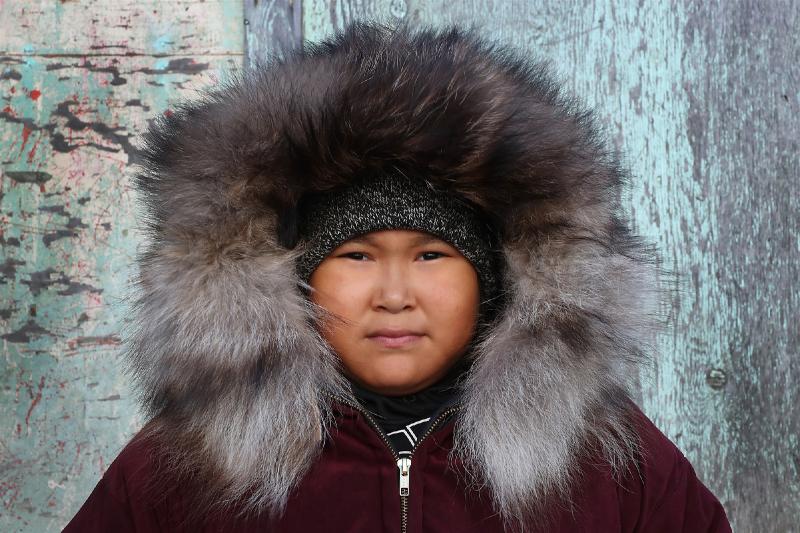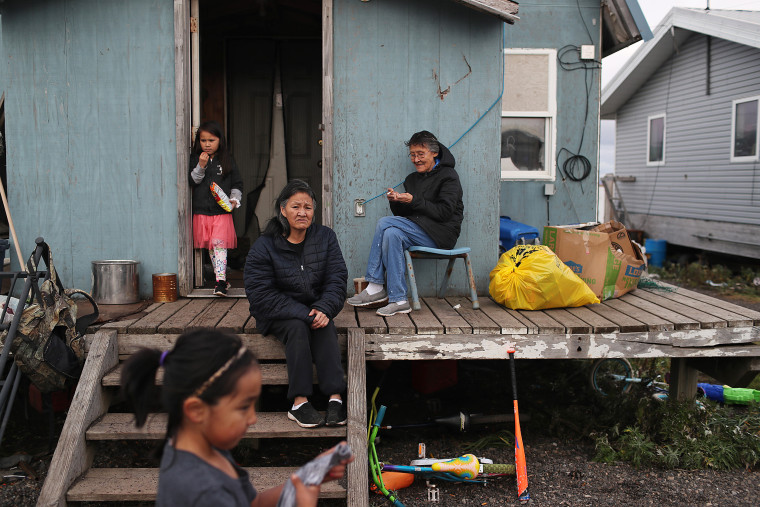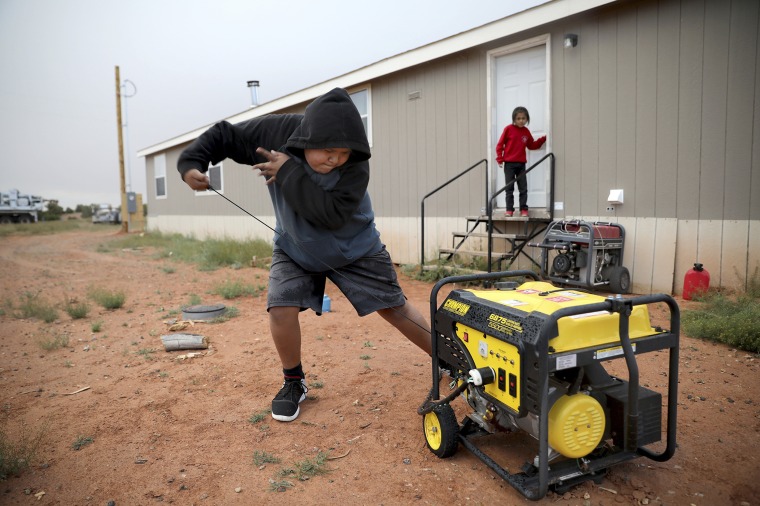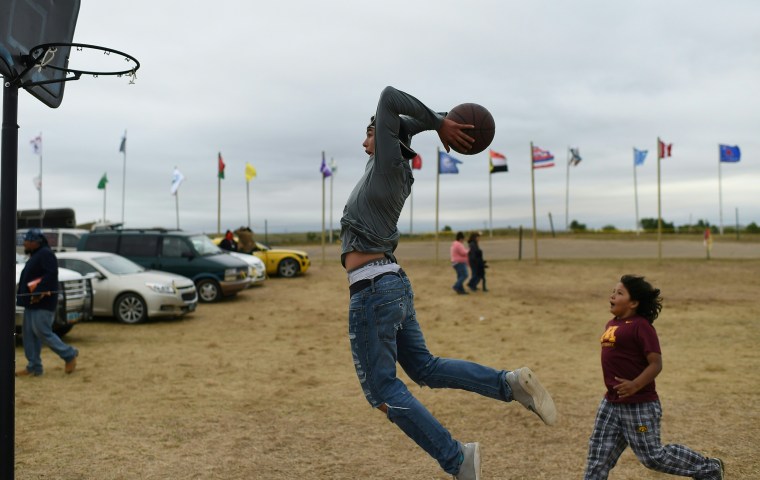Native Americans, the census' most undercounted racial group, fight for an accurate 2020 tally



Native Americans feel like they don't count. And they might not be wrong — they are the most undercounted group on the U.S. census, which means they get significantly less of much needed funding from crucial federal programs, scant improvements on reservation infrastructure and health care, and even the loss of political representation.
But when the census officially kicks off in January in Alaska, it will start in an Alaska Native community three months before the rest of the nation.
It’s an moment touted by the Census Bureau that leads the charge, which tries to get ahead of the many residents who leave following the spring thaw to fish and hunt, and an important moment for the Native community in Alaska, which gets to decide who among their members will be the first counted.
In 2020, the census chose Toksook Bay, a remote Bering Sea community comprised of 94 percent Yup’ik Alaska Natives and where walking is the primary mode of transportation for about two-thirds of the 661 people who live there. Census takers will trek to Alaska’s western coast for the count, and “may need to use a bush plane, dogsled, or snowmobile” to access the area, the bureau said in a statement. The event, a bureau representative has said, will set the tone for the entire nation.
Natalie Landreth, a senior staff attorney at the Native American Rights Fund, thinks the trip is "a lot of PR.”
“They want to show how remote and how far they'll go,” Landreth, of Anchorage, said, “when they don’t do that for the rest of the census.”
 Lizzy Hawley , center, and her sister Ella Hawley, right, relax together on Sept. 10, 2019 in Kivalina, Alaska. Joe Raedle / Getty Images
Lizzy Hawley , center, and her sister Ella Hawley, right, relax together on Sept. 10, 2019 in Kivalina, Alaska. Joe Raedle / Getty Images In 2010, American Indians and Alaska Natives living on reservations were undercounted by 4.9 percent — that’s more than twice the next undercounted group, African Americans, who saw an undercount rate of 2.1 percent. In 1990, the numbers were even more dire: 12 percent of Native Americans living on reservations were missed.
The numbers, Landreth said, are indicative of problems endemic to a count that structurally isn’t written for Native people. And as the 2020 census approaches, groups like Landreth’s are sounding the alarm, worried that Native communities will be undercounted once again.
'This is our census'
Sidra Starkovich will be spending much of 2020 trying to convince her fellow tribe members in the Bois Forte Band of Chippewa to sign up for the census. But Starkovich, an enrolled member of the tribe in charge of her reservations’ Complete Count Committee, has a challenge ahead of her, working against centuries of government mistrust.
 Sidra Starkovich. Sidra Starkovich
Sidra Starkovich. Sidra Starkovich “As indigenous people, we are a little afraid of the government,” she explained, “because we’ve been hurt by the government.”
Starkovich’s first goal, she said, is getting people on the Bois Forte Reservation, which shares a border with Minnesota, to believe her when she says the data they provide the government is confidential. Her neighbors are wary of giving away all their information, and she is quick to explain that specific census data isn’t shared with law enforcement, the government or even the tribe.
She also has to convince the community that the census has a real effect on their day to day lives, from funding for roads and buildings, to resources that the Indian Health Service devotes to their tribe. Some people don’t know that the census translates into cash for the community, but some people who do also just don’t believe that participating will make a real impact.
Starkovich says convincing people on the reservation that the census matters is among her top priorities.
Over $1.5 trillion of federal money is allocated across the country each year based on census data, according to new research from George Washington University. And tribes like Starkovich’s count on federal funding owed to them by treaties with the U.S. and from other laws and agreements.
“If our numbers in the census go down, then our funding levels go down,” she said. “So getting everyone counted, from newborns to elders, is really important.”
But to build trust and encourage census participation, Starkovich says the tribe needs to learn about the census from its own members. Traditional door knocking from census representatives, in her opinion, wouldn’t be effective.
“It can be really intimidating to have a government worker in a fancy car, in a suit and tie, pull up to their house“ Starkovich said, “We want to have people that look like us explaining the census.”
Reservations across the country are trying to get ahead of the census by marketing the count and setting up drives to help the community fill out forms. They’re also actively encouraging their members to apply for census jobs, so that they have their own representatives doing the actual work of the census.
In Bois Forte, the local radio station is running small ad spots, and Starkovich is helping run a poster and social media campaign as well. Their message, she says, is that “this is our census.”
'They didn’t make it for me'
While people like Starkovich are working on their reservations around the country to get a complete count, they’re up against a slew of structural forces impeding an accurate census count.
A large portion of Native people live in areas deemed “hard-to-count” — 78.6 percent of Native people in New Mexico and 65.6 percent of Native people in Alaska live in hard-to count tracks. Households in poverty are also considered more difficult to count, and in 2015, 38.3 percent of Native people living on reservations lived in poverty, according to the National Congress of American Indians. This creates a hard-to-solve bind: poorer communities that are harder to count need more federal funds to alleviate their issues, but to get more cash they need to be accurately counted.
 Jayden Long, 13, starts the generator behind his home on the Navajo Reservation in Arizona so that he can charge his cell phone inside the family home on May 8, 2019. Jake Bacon / AP file
Jayden Long, 13, starts the generator behind his home on the Navajo Reservation in Arizona so that he can charge his cell phone inside the family home on May 8, 2019. Jake Bacon / AP file This is only made worse by the fact that many reservations don’t have the traditional type of addresses that the census asks for, a well-documented problem that reared its head during the 2018 midterms when a North Dakota voter ID law that required a street address on licenses made it difficult for many Native people in the state to vote. When the census office canceled scheduled field tests on reservations in 2017 due to budget issues, hopes that they would address the problem only diminished.
Language access also poses barriers. Navajo is the only Native language with available assistance from the Census Bureau, and there will be no formal help for the dozens of other native languages.
“Native Americans still speak native languages, and the census form is entirely in English,” Landreth said. Navajo assistance, while significant, is not enough, especially for eldery Native people.
Then there’s the problem of the internet, which the 2020 census will largely rely on in an effort to make the count more effective and efficient. But access to the internet in Native communities is far below the nation’s average, and a 2018 dress rehearsal in Providence County, Rhode Island, showed Native communities prefer using the paper form, Landreth said. Added to the list of things that makes getting a complete count of Native communities difficult, advocates fear they have too much working against them.
There are also some more fundamental problems that show up: What if your name is longer than the amount of characters you’re given? What if you refer to the reservation by its local name, not the federal one? What if you write “Choctaw,” instead of “Mississippi Choctaw,” and then the funding goes to the Choctaws in Oklahoma?
“I can see my dad getting to that point and saying, ‘There isn’t even enough room for me to put my tribe name. I’m not gonna do it, it doesn’t fit me, they didn’t make it for me,’” Starkovich said
Congressional representation is another possible repercussion of an undercount. In 2010, Minnesota almost lost its eighth congressional seat, but it managed to hold onto it by just a few thousand people .
“Our political representation is at risk,” Shelly Diaz, the Mille Lacs Band of Ojibwe coordinator for the 2020 census, said. Low counts on reservations could help tip the scales in 2020 and the state could lose that eighth seat.
Diaz also worries the slew of challenges that her community faces to get an accurate count will allow the federal government to shirk its treaty obligations.
“If numbers go down,” Diaz said, “obligations go down.”
Diaz, Starkovich and representatives from Minnesota’s other tribes joined together to form the Minnesota Tribal Census Coalition, a group meant to give the Native people in the state a collective voice. They say the understaffed and overstretched census office is largely receptive to their concerns, but doesn’t always have the bandwidth to address them. The coalition is the first group in the nation of its kind, Starkovich says, and they’re drafting a toolkit to help Native people on reservations across the country mobilize their communities to fill out the census.
The coalition is also worried that Native people who don’t live on reservations won’t be targeted in other census campaigns, which often focus on hard-to-count minority populations, but rarely focus on Native people living in cities.
 Evan Butcher of the Chippewa Tribe plays basketball on Sept. 4, 2016 at the encampment near Cannon Ball, N.D., where hundreds gathered to join the Standing Rock Sioux Tribe's protest of the Dakota Access Pipeline. Robyn Beck / AFP via Getty Images file
Evan Butcher of the Chippewa Tribe plays basketball on Sept. 4, 2016 at the encampment near Cannon Ball, N.D., where hundreds gathered to join the Standing Rock Sioux Tribe's protest of the Dakota Access Pipeline. Robyn Beck / AFP via Getty Images file The Census Bureau, to its credit, is well aware of the issues at hand.
Dee Alexander, the bureau's tribal affairs coordinator, has been traversing the country in preparation for the census, readying tribes for the counts and helping launch public service announcement programs. The bureau coordinates with tribal governments and nonprofits, and says it has met with more than 400 tribal delegates from over 250 tribes, corporations and organizations since 2015.
“We have a good relationship with the tribes,” Alexander said. “We continue today to garner input from the tribes on the programs that will help us collect data.”
National politicians have also tried to help. Sens. Brian Schatz, D-Hawaii, and Lisa Murkowski, R-Alaska, introduced a resolution Dec. 12 meant to ensure the 2020 census count was fair and accurate. Murkowski said in the announcement that “accurate census data provides crucial information for research and planning purposes, directing fair funding allotments for the federal programs that are vital to rural and Native American populations and enabling the enforcement of federal nondiscrimination laws.”
But, ultimately, the burden of getting an accurate count largely falls on the undercounted communities themselves.
Starkovich, who has been doing work with the census for decades, said it’s a responsibility she and the group of volunteers on her reservation working to get a full count are willing to assume.
“Being counted is an exercise of our tribal sovereignty,” she said. “If we aren’t going to be counted, how are they going to live up to fulfilling treaty rights?”


This undercounting of native people has always been a problem. The mistrust of the government (with good reason) for many is one of the main reasons. As explained in the article many reservations are very remote and this also lends itself to the problem.
There are native groups, as explained in the article that are making a very concentrated effort to get everyone counted.
Also mentioned in the article is the urban Indian are many times undercounted for the some of the same reasons as the reservation Indian.
I'm working with the local chapter of AIM to be sure that all native in the Ocala area are counted. Hawaiian Natives and Pacific Islanders are included in this as well.
Guess a really good case in point is in Montana where their census taking negated the rez populations and the state/county refused to have voting booths/stations at or near the rez's. Then there is the stupid azz SD law that stripped the NA's from being allowed to vote due to low count.
Same situation in Wyo and the Dakota's
NA treatment seems to be fairly consistent in red states. if NA's need census numbers, I've long advocated that census forms be used to hinder gerrymandering attempts on certain questions. a simple DNA test result allows the subject to identify as any group that appears on it. I would encourage respondents to balance the nefarious efforts of others by carefully evaluating their answer to each question that could potentially be used against them in the future, especially if they live in gerrymandered districts. completely legal on self-identifying questions.
I think that this is a long time coming. It will not just help with voting but with many other issues on the rez.
Happy 2020 census count to all of us citizens! This is my wish.